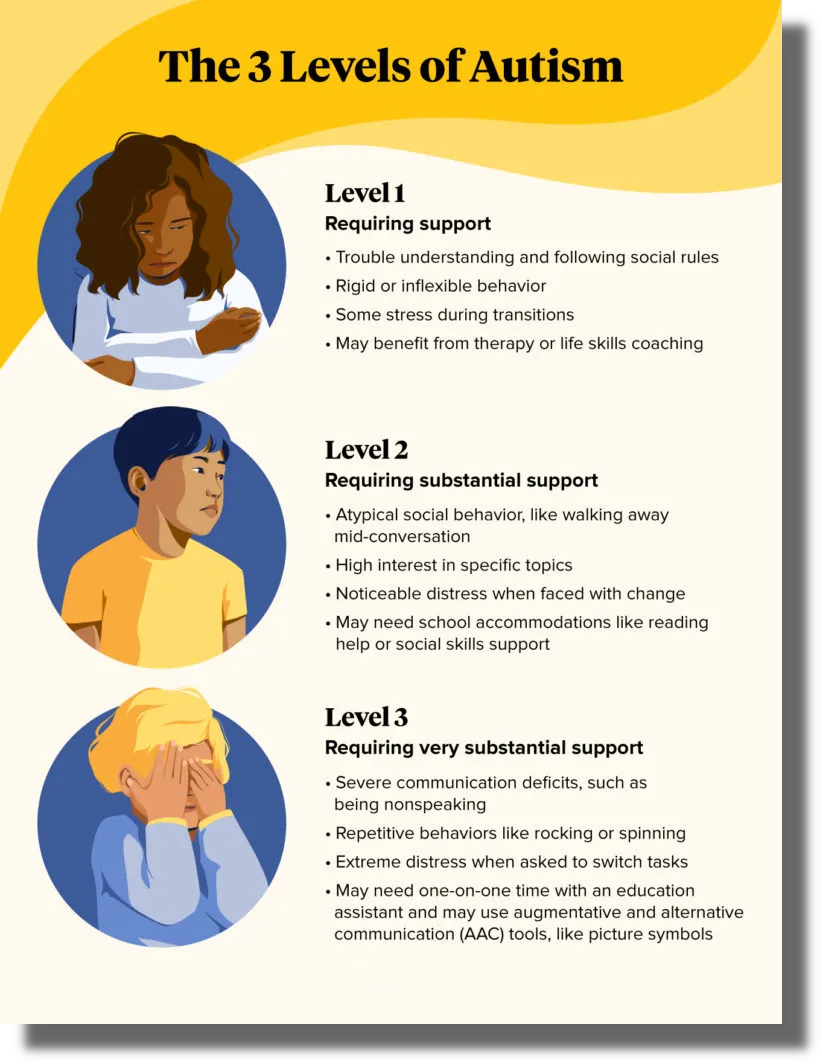Recognizing the Effect of Behavioral Autism on Daily Life and Social Communications
You could not realize exactly how deeply behavioral autism affects life and social interactions. Individuals on the spectrum frequently browse a globe loaded with interaction difficulties and sensory overload. These challenges can bring about disappointment and isolation, impacting their relationships and general wellness. Comprehending these nuances is important for fostering helpful settings. What approaches can we apply to create even more inclusive areas and purposeful links? The responses could surprise you.
Defining Behavior Autism and Its Attributes
Behavior autism, commonly described as autism range disorder (ASD), includes a series of problems identified by obstacles in social communication, communication, and recurring habits. You might see that people with ASD commonly struggle to analyze social cues, which can bring about misunderstandings in discussions. They might discover it hard to establish eye call or take part in small talk, making social scenarios feel frustrating.
Interaction troubles can materialize in different ways, from postponed speech growth to a choice for utilizing fewer words. Recurring actions, such as hand-flapping or rocking, can offer as coping mechanisms to handle tension or sensory overload. These features can exceptionally influence life, making it essential for you to recognize and sustain those with ASD. By acknowledging these qualities, you can foster an environment that promotes approval and encourages efficient communication, assisting people with autism prosper in their day-to-day interactions.
The Range of Autism: Comprehending Variability in Behavior
Autism spectrum disorder (ASD) isn't a one-size-fits-all diagnosis; it differs extensively amongst people. You might run into people that are extremely verbal and engage easily in discussions, while others may choose singular activities or interact non-verbally.
In addition, the means individuals with ASD reply to sensory input can vary substantially; some could be overwhelmed by intense lights or loud noises, whereas others grow in promoting environments. The spectrum additionally consists of distinctions in social interactions; some individuals might have a hard time to interpret social signs, while others navigate social setups with family member convenience. Understanding this irregularity is important, as it aids you appreciate everyone's one-of-a-kind experience and dressmaker support to their details needs, cultivating a much more comprehensive setting for everyone.
Communication Difficulties Faced by People With Autism
When you communicate with people on the autism range, you may observe their unique communication obstacles. They often deal with troubles with both nonverbal and verbal hints, which can influence their social communications. Comprehending these barriers is crucial for fostering better links and assistance.

Verbal Communication Troubles
Lots of individuals on the autism range experience verbal communication difficulties that can considerably affect their daily communications. You may find it challenging to share your thoughts, sensations, or needs plainly. This can result in aggravation for both you and those around you, as misunderstandings happen. You might fight with launching conversations, maintaining a subject, or understanding subtleties in speech. Commonly, you could like using simple language or repeated expressions, which can limit your capacity to take part in deeper conversations. Your rate, quantity, or tone could not align with social assumptions, creating others to misinterpret your purposes. Identifying these difficulties can aid you and your support network create strategies to improve communication and promote much better links with others in your everyday life.
Nonverbal Communication Obstacles
Verbal interaction isn't the only challenge individuals on the autism range face; nonverbal communication barriers can be simply as significant. These obstacles can lead to misunderstandings or misinterpretations of social hints, making interactions feel frustrating or complicated. By dealing with nonverbal communication, you can discover methods to improve your social experiences and improve your overall high quality of life.
Social Communication Impacts
Social communications can usually feel frustrating because of the distinct interaction difficulties faced by individuals with autism. You may deal with analyzing social signs, making it difficult to understand mockery or body movement. This can bring about misconceptions or awkward minutes in discussions. Furthermore, launching and preserving conversations might feel difficult, triggering stress and anxiety in social scenarios. You might choose structured atmospheres, making spontaneous communications awkward. It's also common to experience problem in taking part in tiny talk, which can impede developing brand-new friendships. Acknowledging these difficulties can assist you discover methods to boost interaction, such as exercising social skills in secure settings or using visual aids - Autism Spectrum Therapies. Comprehending your needs allows you to browse social communications with better self-confidence and convenience.
Social Communication and Partnership Building in Autism
While building partnerships can be challenging for people right here with autism, understanding their special perspectives and interaction styles can promote significant links. You may see that lots of people on the range choose straight interaction and may fight with social cues or little talk. By being uncomplicated in your communications, you can help develop an atmosphere where they really feel comfy.
Involving in shared interests can likewise offer as a bridge to much deeper connections. Whether it's a pastime, a favorite show, or a mutual enthusiasm, these common strings can open up doors to relationship.
Daily Life Routine: Browsing Techniques and difficulties
Steering everyday life regimens can be especially testing for individuals with autism, particularly when unexpected changes take place. To browse these obstacles, take into consideration applying visual schedules or lists.
Establishing a regimen that includes sensory breaks can likewise be useful. This helps develop an understanding atmosphere.
Last but not least, method mindfulness techniques to handle anxiety and stress and anxiety. Straightforward breathing workouts or grounding methods can make a considerable distinction. By incorporating these strategies, you can enhance your day-to-day routine and decrease disruptions, making life feel much more manageable.
Staminas and Abilities of Individuals on the Autism Range
Comprehending everyday life regimens is just one facet of the autism experience. Many individuals on the autism range have remarkable strengths and capabilities that establish them apart. You may find that your interest to detail is outstanding, allowing you to master jobs that call for accuracy and emphasis. Your capability to assume outside package can lead to innovative services in various the original source scenarios.
Additionally, your memory abilities frequently beam, specifically in areas of interest. Autism Therapist. This propensity for keeping information can make you a useful resource in fields like art, technology, or science. You might additionally show solid visual thinking, enabling you to envision complicated ideas and fix problems artistically
Furthermore, your one-of-a-kind point of view on the world can cultivate compassion and understanding in others, improving social communications. Embracing these staminas not just increases your self-confidence yet also aids others appreciate the diverse abilities you give the table.
Creating Comprehensive Environments for Individuals With Autism
Creating comprehensive settings for individuals with autism begins with designing sensory-friendly areas that cater to their special demands. You can also cultivate possibilities for social interaction, aiding to build links and relationships. By making these changes, you'll add to a more inviting ambience for everyone.
Designing Sensory-Friendly Spaces
While creating sensory-friendly spaces, it's vital to review the unique requirements of people with autism. Start by selecting relaxing colors and soft lights to produce a comforting environment. Incorporate quiet zones where people can charge and retreat when overwhelmed. You'll intend to lessen loud noises and distractions, using soundproof products or white noise makers to assist maintain tranquility. Take into consideration tactile aspects like soft materials or fidget-friendly items that can give convenience. Establish that areas are adaptable, permitting easy rearrangement to suit different tasks. Ultimately, consist of aesthetic schedules or clear signage to aid individuals navigate the room with confidence. By thoughtfully incorporating these components, you can create a welcoming atmosphere that sustains sensory demands and advertises general wellness.
Advertising Social Interaction Opportunities
Creating sensory-friendly spaces not just addresses individual comfort but likewise establishes the stage for significant social communications amongst individuals with autism. Encourage peer mentoring, pairing individuals with autism with helpful peers that can direct them via social situations. By carrying out these methods, you can enhance social opportunities, aiding individuals with autism construct friendships and enhance their social abilities in a secure, inviting setting.

Frequently Asked Inquiries
Just How Can Pals Support Someone With Behavioral Autism?
You can support a good friend with behavioral autism by being client, paying attention actively, and valuing their limits. Participate in activities they delight in, interact freely, and develop a comfy environment where they feel valued and understood.
What Resources Are Available for Parents of Children With Autism?
You can check out various sources for parents of children with autism, including support system, instructional internet sites, and neighborhood social work. Getting in touch with various other moms and dads can likewise offer important insights and shared experiences to aid browse challenges.
Can Behavioral Autism Adjustment Gradually?

Yes, behavioral autism can change gradually. You might notice shifts in interaction, social skills, and habits as your child grows. Early treatment and support usually play vital roles in these developing adjustments.
Exactly How Do Sensory Level Of Sensitivities Affect Day-to-day Live?
Sensory sensitivities can make daily experiences frustrating. You might deal with loud noises or bright lights, resulting in anxiety or evasion. Locating settings that accommodate your needs can substantially improve your comfort and total every day life.
What Are Typical Misconceptions Regarding Behavioral Autism?
You may assume behavior autism just affects communication abilities, but it's more facility. Several think people do not have compassion or intelligence, which isn't true. Comprehending these mistaken beliefs helps foster approval and assistance for those on the range.
Behavioral autism, often referred to as autism spectrum disorder (ASD), encompasses a range of conditions defined by difficulties in social communication, interaction, and recurring actions.Social communications can often feel frustrating due to the one-of-a-kind communication difficulties faced by individuals with autism.Designing sensory-friendly areas not only addresses individual convenience however also sets the stage for meaningful social communications amongst individuals with autism. Motivate peer mentoring, matching people with autism with helpful peers who can guide them through social scenarios. browse this site By applying these approaches, you can boost social chances, helping people with autism construct relationships and strengthen their social abilities in a safe, inviting setting.
Comments on “Comprehensive guide for working with Autism Spectrum Therapies providers”